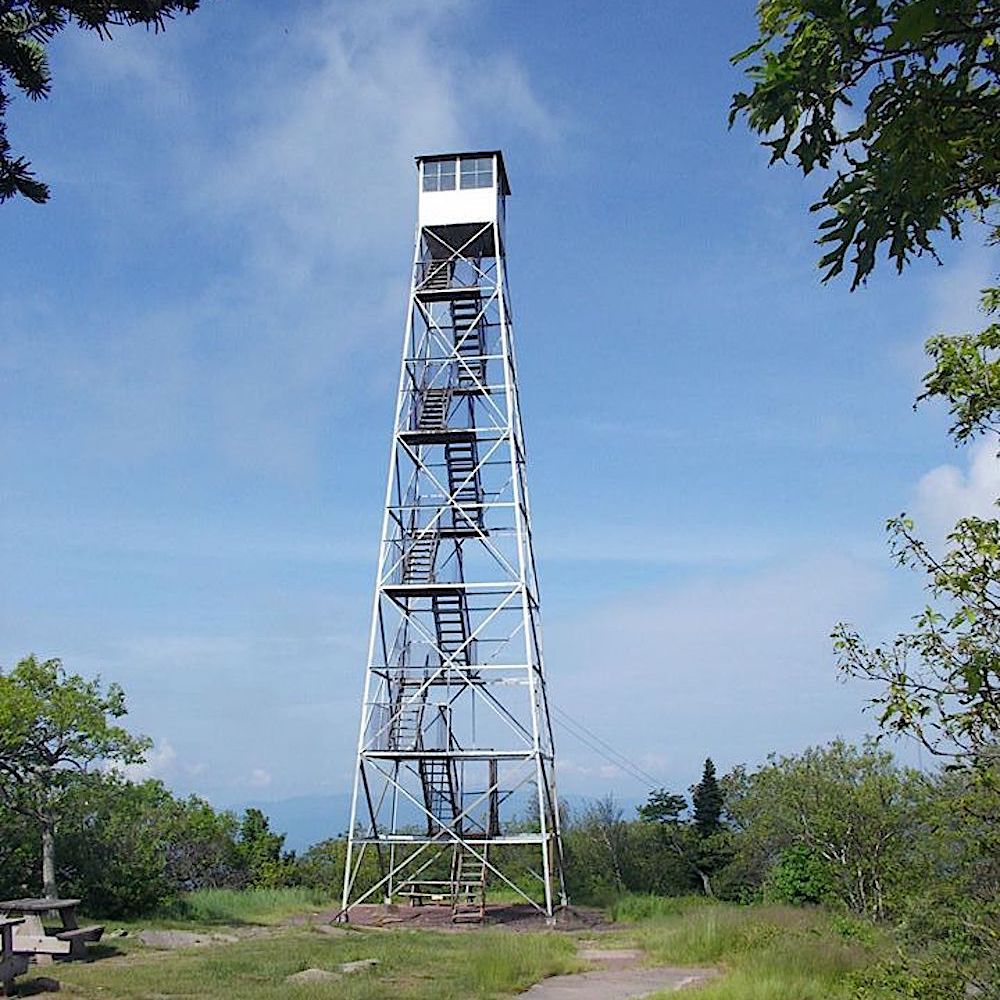
Are You Ready to Take The Catskills Fire Tower Challenge?
If you love to hike the Catskill Mountains, you may have already experienced the awesome experience of climbing one of our six fire towers with sweeping views of the valley below. There’s nothing quite like it. If you’re an experienced hiker, you’re encouraged to take the 2023 Catskill Fire Tower Challenge by visiting the region’s six fire towers between January 1 and December 31.
You don’t have to climb all the way to the cab but unless you suffer a fear of heights, it would be foolish not to because the breathtaking views are just too good to miss. With each visit, just complete your log and submit one of your favorite photos. At the end of your journey, you’ll receive a commemorative patch and be entered to win great outdoor prizes, including cool hiking accessories.

The Fire Tower at Hunter Mountain | Source: Scenic Catskills
- Overlook Mountain – Woodstock, NY
- Hunter Mountain – Hunter, NY
- Red Hill Mountain – Denning, NY
- Balsam Lake Mountain – Hardenburgh, NY
- Tremper Mountain – Shandaken, NY
- Upper Esopus – Mt. Tremper, NY
+ + +
DID YOU KNOW?
For nearly a century, observers watched the forests of New York State–including the Catskill and Adirondack forest preserves– from over 100 fire towers perched atop the highest peaks, vigilantly searching for the telltale signs of forest fires. INSIDE+OUT turned to our local expert and hiking guide, “Ranger Dave” Holden to tell us more.
RANGER DAVE: When the first settlers arrived in what we now call the Catskills and the Hudson Valley, they must have been absolutely amazed at such a pristine paradise. Inhabited by the indigenous Haudenosaunee, Mahican and Munsee peoples, the area was cultivated into carefully manicured groves of hemlock, pine, maple and oak. The forests, interspersed with extensive, rich gardens, were lovingly nurtured for their unique products: healing salves, wood for building and utensils, syrups, and foodstuff. Firewood was harvested from fallen or standing deadwood (called “goomootch” by my Micmac ancestors).
After Natives were cajoled or swindled out of their land, settlers extracted whatever “value” they could to be sold or otherwise misused. Valleys were cleared for inefficient European agricultural purposes and large-scale animal husbandry contributed significantly to widespread erosion and major flooding events. The introduction of swine quickly ruined native gardens in ancestral bottomlands and wild roots that had long been cultivated. These practices, distinctly out of harmony with the land, started the road to destruction in the region.
From Paradise to Perdition. During the 1800s, with no regulations in place, hardwoods and pines were over-logged, and Hemlocks were destroyed to make tan-bark. Virtually the entire landscape was dug up with millions of stumps and immense piles of slash (unmarketable remains of branches and trees) strewn across the once-pristine landscape. So it was no wonder many trains hauling lumber often ignited fires from sparks escaping their wood-fueled smokestacks. Small and medium-sized fires were therefore quite common.
In 1885, both Catskill Park and Adirondack Park were founded to remedy this situation. But it wasn’t until the great fires of 1903 and 1908 that the impetus finally occurred to protect the nearly-ruined land. The parks were meant to enforce fire protection as the fires became widespread and truly disastrous due to wide-ranging and long-lasting droughts. Indeed, some small towns in the Adirondacks were simply wiped out. Many wild animals died in these fires, including large numbers of fish that perished from the lye that resulted from wood ash from burnt trees mixing with stream water. Drinkable water became widely unavailable and the sky was ash-laden for months at a time.
New York State finally got serious about fires, intially by setting up a few (primarily wooden) manned observation towers, eventually changing to metal towers with enclosed observatories, called cabs. New York State would ultimately have 102 fire towers, spread out mainly in the Adirondacks and Catskills (which initially had 23).
When airplanes became the primary method to observe and track forest fires, the towers’ usefulness soon became a thing of the past. Most were closed, and many were removed. (For more on this important history, I highly recommend Martin Podskoch’s entertaining and informative book, “Fire Towers of the Catskills – Their History and Lore.”)
The last five towers in the Catskills – Balsam Lake Mountain, Hunter Mountain, Mt. Tremper, Overlook Mountain and Red Hill – sat abandoned for years. Thankfully, through the passionate efforts of volunteers, coordinated with the expertise of Catskill Center and NYSDEC, the towers were eventually refurbished and brought back to life.
This program has been very successful, and I’m proud to have personally played a role in reopening the Overlook Fire tower. In 2019, the Catskill Center and the DEC erected a new fire tower on the grounds of their shared Catskills Visitor Center (CVC) – the Upper Esopus Fire tower (www.catskillsvisitorcenter.org). Thus, we now have 6 Catskills fire towers; each is part of the Catskills Fire Tower Challenge and they’re accessible by hikes of different lengths. Personally, I think the Visitor Center is the most logical place to start, but you can also begin your Challenge with the Upper Esopus fire tower as it’s only a short walk.
Here are Dave’s Top Ten Hiking Tips:
- Be prepared for hiking trails of all levels.
- Bring a map and know how to use it.
- Follow requirements for a safe and healthy outdoor experience.
- Whenever you visit, bring out what you brought in (Leave No Trace).
- Stay in touch with the CVC for updated Trail Conditions.
- Watch the weather!
- Dress accordingly, sometimes in layers. Adequate footwear is essential – ideally waterproof, but at least with ankle support.
- Bring plenty of water – there are occasional springs, but don’t rely on them. Snacks are always good.
- Always have a flashlight with you, especially as the days start to shorten.
- Please sign in and out at register-boxes where available and use #catskillcenter when texting.
Thank you, “Ranger” Dave Holden
Website | Instagram | Facebook
The featured photo is of the Fire Tower at Overlook Mountain in Woodstock NY
Write a Comment
You must be logged in to post a comment.





